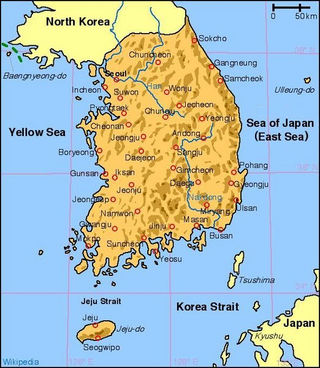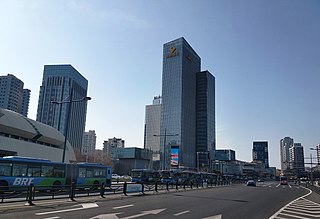
South Korea is located in East Asia, on the southern portion of the Korean Peninsula located out from the far east of the Asian landmass. The only country that shares a land border with South Korea is North Korea, lying to the north with 238 kilometres (148 mi) of the border running along the Korean Demilitarized Zone. South Korea is mostly surrounded by water and has 2,413 kilometres (1,499 mi) of coast line along three seas; to the west is the Yellow Sea, to the south is the East China Sea, and to the east is the Sea of Japan. Geographically, South Korea's landmass is approximately 100,364 square kilometres (38,751 sq mi). 290 square kilometres (110 sq mi) of South Korea are occupied by water. The approximate coordinates are 37° North, 128° East.
Sea bass is a common name for a variety of different species of marine fish. Many fish species of various families have been called sea bass.

The Sea of Japan(see below for other names) is the marginal sea between the Japanese archipelago, Sakhalin, the Korean Peninsula, and the mainland of the Russian Far East. The Japanese archipelago separates the sea from the Pacific Ocean. Like the Mediterranean Sea, it has almost no tides due to its nearly complete enclosure from the Pacific Ocean. This isolation also affects faunal diversity and salinity, both of which are lower than in the open ocean. The sea has no large islands, bays or capes. Its water balance is mostly determined by the inflow and outflow through the straits connecting it to the neighboring seas and the Pacific Ocean. Few rivers discharge into the sea and their total contribution to the water exchange is within 1%.

The East China Sea is a marginal sea of the Western Pacific Ocean, located directly offshore from East China. China names the body of water along its eastern coast as "East Sea" due to direction, the name of "East China Sea" is otherwise designated as a formal name by International Hydrographic Organization (IHO) and used internationally.

A dispute exists over the international name for the body of water which is bordered by Japan, Korea and Russia. In 1992, objections to the name Sea of Japan were first raised by North Korea and South Korea at the Sixth United Nations Conference on the Standardization of Geographical Names. The Japanese government supports the exclusive use of the name "Sea of Japan", while South Korea supports the alternative name "East Sea", and North Korea supports the name "Korean East Sea". Currently, most international maps and documents use either the name Sea of Japan by itself, or include both the name Sea of Japan and East Sea, often with East Sea listed in parentheses or otherwise marked as a secondary name. The International Hydrographic Organization, the governing body for the naming of bodies of water around the world, in 2012 decided it was still unable to revise the 1953 version of its publication S-23 – Limits of Oceans and Seas, which includes only the single name "Sea of Japan", to include "East Sea" together with "Sea of Japan".
There are various names of Korea in use today that are all derived from those of ancient Koreanic kingdoms and dynasties. The choice of name often depends on the language, whether the user is referring to either or both modern Korean countries, and even the user's political views on the Korean conflict.

The Orient is a term referring to the East in relation to Europe, traditionally comprising anything belonging to the Eastern world. It is the antonym of the term Occident, which refers to the Western world.

Samcheok is a city in Gangwon Province, South Korea. To the west are the Taebaek Mountains, which form a high flat plain of more than 1,000 meters, and to the east, the coastal plain slopes sharply. It borders Donghae in the north, Uljin County in North Gyeongsang Province in the south, and Taebaek in the west. It covers an area of 1,185.86 km2 and has a coastline of 58.4 km.The city hall is located in Gyo-dong, and the administrative area includes 2 districts, 6 villages, and 4 dongs. The tree symbolizing the city is the zelkova, the bird is the seagull, and the flower is the azalea. Samcheok has the lowest population density of any autonomous city in Korea.
Donghae (Korean: 동해) may refer to:

Lianyungang is a prefecture-level city in northeastern Jiangsu province, China. It borders Yancheng to its southeast, Huai'an and Suqian to its south, Xuzhou to its southwest, and the province of Shandong to its north. Its name derives from Lian Island, the largest island in Jiangsu which lies off its coastline, and Yuntai Mountain, the highest peak in Jiangsu, a few miles from the city center, and the fact that it is a port. The name can be literally translated as the Port Connecting the Clouds.
"The Seven Seas" is a figurative term for all the seas of the known world. The phrase is used in reference to sailors and pirates in the arts and popular culture and can be associated with the Mediterranean Sea, the Arabian Seven Seas east of Africa and India, or is sometimes applied to the Caribbean Sea and seas around the Americas.
Tōkai in Japanese may refer to:
South Sea, South Seas or Southsea may refer to:
The East Sea, one of the Four Seas, is identified as the body of water east of the mainland according to ancient Chinese geography. In Chinese literature, the Four Seas are a metaphor for the boundaries of China. It contains modern day East China Sea as well as the Yellow Sea and Bohai Sea.
東海 or 东海 means "East Sea" or "Eastern Sea" in Chinese characters.
東, meaning "east", may refer to:
Tunghai, Tung Hai, Tung-Hai may refer to:
This page is based on this
Wikipedia article Text is available under the
CC BY-SA 4.0 license; additional terms may apply.
Images, videos and audio are available under their respective licenses.






